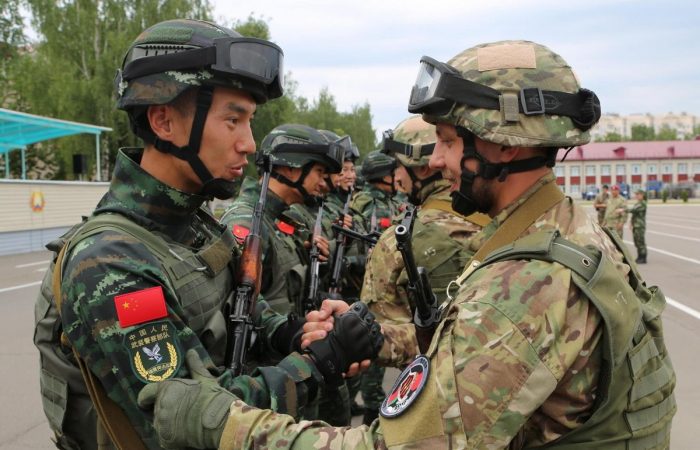When President Biden defended his decision to withdraw U.S. forces from Afghanistan on August 16, 2021, he identified “preventing a terrorist attack on the American homeland” as the United States’ “only vital national interest in Afghanistan.” This narrow focus notably parallels a recent tone struck by Chinese Foreign Minister Wang Yi, who remarked that the Taliban must “resolutely crack down on all kinds of terrorist organizations and avoid becoming a gathering place for terrorists again.” While the U.S. and China are in rare agreement that Afghanistan must not become a safe haven for terrorists, their diametrically opposed narratives of what the withdrawal means for great power competition make trivial ‘cheap shots’ at the other’s expense more attractive than finding a happy medium on counterterrorism going forward. Policymakers and commentators must not unknowingly play into this dynamic, regardless of how tempting it may be in the short term. Both nations should not miss opportunities for enhancing absolute security through cooperative frameworks; getting trapped in a zero-sum game could threaten both relative gains and the lives of civilians and service members targeted by Afghan-based terrorists.
U.S. Interests in a Post-Withdrawal Afghanistan
Much of Washington’s justification for withdrawing from Afghanistan rests on the claim that U.S. war aims metastasized beyond the originally narrow interest of suppressing a terrorist threat to the U.S. homeland. Building on Biden’s historically restrained approach to the Afghan conflict, National Security Advisor Jake Sullivan justified the administration’s rationale on August 17 saying “we have been successful to date in suppressing the terrorist threat to the U.S. Homeland…without sustaining a permanent military presence or fighting in a war.” Sullivan reiterated this strategy in an August 23 press conference on ISIS-Khorasan Province (ISIS-K). He described ISIS-K, an Islamic State branch which controls territory in Afghanistan’s eastern Nangarhar and Kunar provinces, as the new “laser focus” of the Biden administration’s counterterrorism efforts in Afghanistan after “serious” and “very credible” threats to U.S. forces aiding in the evacuation of asylum seekers in Kabul emerged. These concerns were unfortunately corroborated on August 26 when a suicide bombing by ISIS-K outside the Hamid Karzai International Airport killed at least 13 U.S. service members and 169 Afghans, including 28 Taliban guards, with hundreds more injured.
Washington’s emerging ‘over-the-horizon’ campaign against ISIS-K could require cooperation with the Taliban and other regional actors. Upon taking power in Afghanistan, the resurgent Islamic Emirate moved quickly to secure its porous borders against insurgent smuggling and began sharing counter-terrorist intelligence with the United States. On paper, these moves are in line with U.S. interests; according to Secretary of State Antony Blinken, “A future Afghan government that upholds the basic rights of its people and that doesn’t harbor terrorists is a government we can work with and recognize.” However, the United Kingdom and Canada have already refused to recognize the Taliban government, and, amid pressure from Western allies and human rights activists, it is unclear if consultations of the international community in the coming month will provide Biden with the leeway to normalize U.S.-Afghan relations and meaningfully leverage the Taliban’s counter-terrorist commitments.
China’s Interests in Afghanistan and Reaction to the U.S. Withdrawal
China, on the other hand, approached the Taliban takeover of Afghanistan with much less baggage. Beijing’s interests in Afghanistan have always centered pragmatically around the security of its economic concerns and the potential threat that Islamic militants pose across its borders. In 2018, this meant bolstering the Afghan National Army to push Uyghur militants away from the border with Xinjiang and the China-Pakistan Economic Corridor. By 2021 however, Beijing recognized which way the wind was blowing and invited a Taliban delegation to Tianjin, securing assurances that the group would cut ties with the East Turkestan Islamic Movement (ETIM); a Uyghur terrorist group responsible for high-profile attacks on Chinese soil like the 2013 Tiananmen Square car attack and various attacks ahead of the 2008 Olympics. However, a July UN Security Council report found that hundreds of ETIM fighters are still active in the Badakhshan Province of Afghanistan.
Chinese officials regard the ETIM presence in post-withdrawal Afghanistan as a persistent threat that requires cooperation with the Taliban and international actors to root out. On a phone call with Secretary Blinken on August 17, Foreign Minister Wang raised this point directly when he criticized the Trump administration’s removal of ETIM from the U.S. list of designated terrorist groups. Wang told Blinken that this demonstrated a “double standard…on the issue of counter-terrorism” and that the U.S. ought to “change course and remove obstacles to…Afghan-related cooperation between China and the United States.” The cooperation between ETIM’s diaspora arm and ISIS in the Middle East is a source of alignment between Chinese and U.S. counterterrorism priorities; but in spite of these beseechments from Chinese officials, including President Xi Jinping, Washington may continue to turn a blind eye to ETIM unless credible reports of their cooperation with ISIS-K, the more acute threat according to U.S. intelligence than the Levantine rump state, emerge.
Cooperation Stifled Despite an Alignment of Interests
Despite few points of substantive contention and only slight misalignment of priorities between American and Chinese counterterrorism interests, there remains a distinct lack of cooperation between the two countries in Afghanistan. For both rivals, there appears to be a strong aversion to giving the other side ‘a win’—even if mutually beneficial—when taking ‘cheap shots’ at each other is comparably easy.
For the U.S., even a cynical analysis of the situation would suggest that now is the time to ‘keep its enemy close’ and prevent China from exploiting the power vacuum to grow its coffers or secure its particular interests; both of which they are already doing just weeks after the fall of Kabul. Instead, the Biden administration and much of the U.S. media are ignoring the potential to cooperate with China to advance mutual interests; instead, arguing through a zero-sum lens that the withdrawal ‘frees up’ U.S. forces for a pivot to confronting China or that any Chinese engagement with Afghanistan will also draw them into the ‘graveyard of empires.’
Beijing too must realize that the United States’ long experience in Afghanistan and numerous military bases in neighbouring Central Asian states could be valuable assets in jointly confronting the threat ETIM and ISIS-K pose to China. However, while some Chinese officials made appeals to the U.S., Chinese state media spent days ridiculing the Biden administration for the messiness of the exit. MFA Spokesperson Hua Chunying was quick to spin Biden’s repudiation of ‘nation-building’ in Afghanistan as evidence that the U.S. is serially “destructive rather than constructive.” Xinhua declared that “The fall of Kabul marks the collapse of the U.S.’ international image and credibility” while Global Times argued that the U.S. withdrawal should serve as a “warning bell to secessionists in Taiwan.” This juxtaposing discourse reveals Beijing’s continued ambivalence on U.S.-China collaboration in Afghanistan and, given Washington’s cold shoulder, it is unlikely that advocates of cooperation will prevail.
The U.S. withdrawal from Afghanistan feeds into two competing narratives of U.S.-China relations: an American narrative of a pivot from unilateral nation-building into great power competition and a Chinese narrative that the U.S. is a declining power whose death spasms beget global disorder. Despite the substantive alignment of Sino-American counterterrorism interests in Afghanistan, these conflicting narratives of the withdrawal make cooperation extremely difficult. Whether Beijing can hold the Taliban to its anti-ETIM commitments and secure its economic interests in Afghanistan without getting enmeshed in its own doomed intervention remains to be seen, as does Washington’s belief that its ‘over-the-horizon’ capacities will keep terrorism at bay while freeing up resources for a shift eastwards. What is clear is that a counterterrorism arrangement involving the U.S. and China in Afghanistan—with some degree of intelligence sharing on terrorist groups, synergy of existing counter-terrorist assets and relationships in Central Asia, and coordination of strategy vis-à-vis cooperating with or pressuring the Taliban government—would be more conducive to both countries’ interests than trivial, rhetorical competitions.




